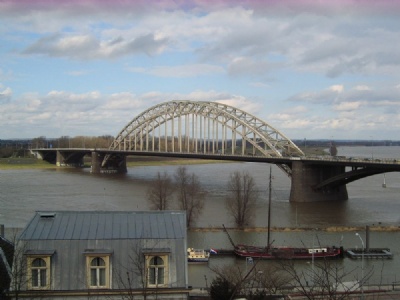Arnhem
The West-allied landing in Normandy in June 1944 and the Soviet Union’s major offensive, Operation Bagration, just two weeks later meant that the German army suffered heavy losses in both men and materials and were pushed back. Before the end of the summer, France had been liberated and the Soviet Red Army had reached Warsaw outskirts. There were hopes that the war might be over by the end of the year. To achieve this the British field marshal Montgomery suggested an airborne operation into Holland with the mission to take a number of important bridges. This would hasten the offensive against Germany and the final victory. The Western Allied supreme commander, Eisenhower, approved the operation which was named Operation Market Garden. Market stood for the airborne forces and Garden for the ground forces.
About 35,000 airborne soldiers from American 82nd 101st and 1st airborne divisions and a Polish brigade participated. About 14,500 landed with paragliders who landed silently in strategic locations and about 20,500 parachuted. The operation is the largest airborne military operation of all time. The task of the troops was to take important bridges and keep them until they were relieved by ground troops. The Operation began on 17 September, 1944, and the troops landed in areas around Eindhoven, Nijmegen, Groesbeek, Overasselt, Oosterbeek and Arnhem. What the western allies did not know was that in the area around the bridge furthest away, Arnhem, there were the 9th and 10th armoured divisions of the 2nd SS armored corps at rest. These had suffered severe losses after the landing in Normandy and needed to recover.
In the initial phase of the operation, the western allies reaped success, but quite soon the German forces mobilized and counter attacked. Although the operation was carried out in a large area, it is best known for the battle at the bridge at Arnhem. The bridge at Arnhem was to be taken and held by British forces under the command of lieutenant Colonel John Frost. The original plan was for Frost to hold the bridge and eventually being relieved by the British 30th corps. However, problems arose fairly quickly for the ground troops because there was only one major road leading to Arnhem. The Road was also narrow and German attacks made the advance slower than planned. Eindhoven, which was close to the front line, was liberated quite soon. Even Nijmegen with an important bridge over the Waal river was conquered after fierce fighting despite the Germans trying to dynamite the bridge. Part of the American 82nd division conducted a heroic and bloody river crossing about two kilometers south of the bridge in small boats to attack the bridge from the north. The river crossing was called by the soldiers who attended, Little Omaha, because it reminded of the fighting at Omaha beach in Normandy earlier that year.
At Arnhem, the pressure from the Germans on the British forces became increasingly severe and it proved impossible to relieve the forces at the bridge. The Germans attacked the British from several directions and they had problems with communication, lack of ammunition and other supplies. British forces at the Arnhem bridge were forced to surrender on September 20. The British commander Major-General Uruqhart had its headquarters in Oosterbeek, about five kilometers north of Arnhem, in the former German field marshal Model headquarters. But even around Oosterbeek increased pressure on the British. The British defense around Oosterbeek consisted of two lines of defense in a circle around the city. But this line was worned down by the constant pressure from the gemans and could not be hold.
The British were in desperate need of reinforcements and these were on the north side of river Rhine. It was the Polish 1st voluntary paratrooper brigade under the command of Major General Stanislaw Sosabowski who tried to come to the rescue. On three occasions, Sosabowski tried to move reinforcements to the British on the south side without success. The German defense, the hard river current and the lack of suitable landing sites meant that only about 200 people managed to cross the river. On the evening of September 25, British forces began evacuating from Oosterbeek via Rhine and about 2,500 men managed get back to safety. The day after, the remaining forces surrendered, which was the end of Operation Market garden.
Arnhem, who had escaped major damages before the operation, was completely destroyed during the battle. The western allied losses amounted to about 16,000 while the German losses amounted to between 7,500 and 10,000. Arnhem was finally liberated in February 1945.
Current status: Partly preserved/demolished with museum, monument and cemeteries (2011).
Address: Utrechtseweg 232, 6862 AZ Oosterbeek (Hartenstein).
Get there: Car.
Follow up in books: Ryan, Cornelius: A Bridge to Far (1976).















The Bridge at Arnhem was destroyed during the battle but was rebuilt after the war.In 1978 the bridge was renamed John Frost bridge after the British commander of the forces at the bridge. About a kilometer from the museum in Oosterbeek there is a atmospheric war cemetery. In the hotel Hartenstein there is an interesting museum about the whole operation. Arnhem is otherwise what Omaha Beach is to Normandy and what Bastogne is to the Ardenner offensive, a focal point for a larger battle. But Market Garden is so much more than just Arnhem but it is Arnhem that has had the historical impact due to the events at the bridge and where the battle was decided. But just like in Normandy and the Ardennes, there is so much more to discover in Holland and not just Arnhem. Places such as Wolfheze, Groesbeek, Oosterbeek, Overasselt, Driel, Elst, Son, Overloon, Nijmegen and others are also strongly linked to the operation. This can be seen and are remembered through numerous museums, monuments and war cemeteries. For those who want to explore the whole area, there is a large selection that is most easily reached by car.